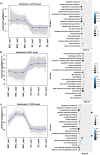Transcriptomic profiles of non-embryogenic and embryogenic callus cells in a highly regenerative upland cotton line (Gossypium hirsutum L.)
- PMID: 33267776
- PMCID: PMC7713314
- DOI: 10.1186/s12861-020-00230-4
Transcriptomic profiles of non-embryogenic and embryogenic callus cells in a highly regenerative upland cotton line (Gossypium hirsutum L.)
Abstract
Background: Genotype independent transformation and whole plant regeneration through somatic embryogenesis relies heavily on the intrinsic ability of a genotype to regenerate. The critical genetic architecture of non-embryogenic callus (NEC) cells and embryogenic callus (EC) cells in a highly regenerable cotton genotype is unknown.
Results: In this study, gene expression profiles of a highly regenerable Gossypium hirsutum L. cultivar, Jin668, were analyzed at two critical developmental stages during somatic embryogenesis, non-embryogenic callus (NEC) cells and embryogenic callus (EC) cells. The rate of EC formation in Jin668 is 96%. Differential gene expression analysis revealed a total of 5333 differentially expressed genes (DEG) with 2534 genes upregulated and 2799 genes downregulated in EC. A total of 144 genes were unique to NEC cells and 174 genes were unique to EC. Clustering and enrichment analysis identified genes upregulated in EC that function as transcription factors/DNA binding, phytohormone response, oxidative reduction, and regulators of transcription; while genes categorized in methylation pathways were downregulated. Four key transcription factors were identified based on their sharp upregulation in EC tissue; LEAFY COTYLEDON 1 (LEC1), BABY BOOM (BBM), FUSCA (FUS3) and AGAMOUS-LIKE15 with distinguishable subgenome expression bias.
Conclusions: This comparative analysis of NEC and EC transcriptomes gives new insights into the genes involved in somatic embryogenesis in cotton.
Keywords: Callus, embryo; Gossypium hirsutum L; Somatic embryogenesis.
Conflict of interest statement
The authors declare that they have no competing interests.
Figures







Similar articles
-
Comparative Transcriptomics of Non-Embryogenic and Embryogenic Callus in Semi-Recalcitrant and Non-Recalcitrant Upland Cotton Lines.Plants (Basel). 2021 Aug 26;10(9):1775. doi: 10.3390/plants10091775. Plants (Basel). 2021. PMID: 34579308 Free PMC article.
-
Dynamic Transcriptome Analysis Reveals Uncharacterized Complex Regulatory Pathway Underlying Genotype-Recalcitrant Somatic Embryogenesis Transdifferentiation in Cotton.Genes (Basel). 2020 May 7;11(5):519. doi: 10.3390/genes11050519. Genes (Basel). 2020. PMID: 32392816 Free PMC article.
-
iTRAQ-based comparative proteomic analysis provides insights into somatic embryogenesis in Gossypium hirsutum L.Plant Mol Biol. 2018 Jan;96(1-2):89-102. doi: 10.1007/s11103-017-0681-x. Epub 2017 Dec 6. Plant Mol Biol. 2018. PMID: 29214424 Free PMC article.
-
Current Perspectives on the Auxin-Mediated Genetic Network that Controls the Induction of Somatic Embryogenesis in Plants.Int J Mol Sci. 2020 Feb 16;21(4):1333. doi: 10.3390/ijms21041333. Int J Mol Sci. 2020. PMID: 32079138 Free PMC article. Review.
-
Epigenetic modifications and miRNAs determine the transition of somatic cells into somatic embryos.Plant Cell Rep. 2023 Dec;42(12):1845-1873. doi: 10.1007/s00299-023-03071-0. Epub 2023 Oct 4. Plant Cell Rep. 2023. PMID: 37792027 Review.
Cited by
-
Cryo-Treatment Enhances the Embryogenicity of Mature Somatic Embryos via the lncRNA-miRNA-mRNA Network in White Spruce.Int J Mol Sci. 2022 Jan 20;23(3):1111. doi: 10.3390/ijms23031111. Int J Mol Sci. 2022. PMID: 35163033 Free PMC article.
-
Transcriptome Analysis of Embryogenic and Non-Embryogenic Callus of Picea Mongolica.Curr Issues Mol Biol. 2023 Jun 21;45(7):5232-5247. doi: 10.3390/cimb45070332. Curr Issues Mol Biol. 2023. PMID: 37504248 Free PMC article.
-
Primary Metabolite Screening Shows Significant Differences between Embryogenic and Non-Embryogenic Callus of Tamarillo (Solanum betaceum Cav.).Plants (Basel). 2023 Aug 4;12(15):2869. doi: 10.3390/plants12152869. Plants (Basel). 2023. PMID: 37571022 Free PMC article.
-
The improvement of the in vitro plant regeneration in barley with the epigenetic modifier of histone acetylation, trichostatin A.J Appl Genet. 2024 Feb;65(1):13-30. doi: 10.1007/s13353-023-00800-9. Epub 2023 Nov 14. J Appl Genet. 2024. PMID: 37962803 Free PMC article.
-
Embryogenic Stem Cell Identity after Protoplast Isolation from Daucus carota and Recovery of Regeneration Ability through Protoplast Culture.Int J Mol Sci. 2022 Sep 30;23(19):11556. doi: 10.3390/ijms231911556. Int J Mol Sci. 2022. PMID: 36232857 Free PMC article.
References
-
- Dunwell JM. Transgenic approaches to crop improvement. J Exp Bot 2000; 51 Spec No:487–496. - PubMed
-
- Mccabe DE, Swain WF, Martinell BJ, Christou P. Stable transformation of soybean (glycine-max) by particle-acceleration. Bio-Technol. 1988;6(8):923–926.
-
- Cho MJ, Yano H, Okamoto D, Kim HK, Jung HR, Newcomb K, Le VK, Yoo HS, Langham R, Buchanan BB, Lemaux PG. Stable transformation of rice (Oryza sativa L.) via microprojectile bombardment of highly regenerative, green tissues derived from mature seed. Plant Cell Rep. 2004;22(7):483–489. doi: 10.1007/s00299-003-0713-7. - DOI - PubMed
-
- Gordon-Kamm WJ, Spencer TM, Mangano ML, Adams TR, Daines RJ, Start WG, O'Brien JV, Chambers SA, Adams WR, Jr, Willetts NG, Rice TB, Mackey CJ, Krueger RW, Kausch AP, Lemaux PG. Transformation of maize cells and regeneration of fertile transgenic plants. Plant Cell. 1990;2(7):603–618. doi: 10.2307/3869124. - DOI - PMC - PubMed
-
- Altpeter F, Springer NM, Bartley LE, Blechl AE, Brutnell TP, Citovsky V, Conrad LJ, Gelvin SB, Jackson DP, Kausch AP, Lemaux PG, Medford JI, Orozco-Cardenas ML, Tricoli DM, Van Eck J, Voytas DF, Walbot V, Wang K, Zhang ZJ, Stewart CN., Jr Advancing crop transformation in the era of genome editing. Plant Cell. 2016;28(7):1510–1520. - PMC - PubMed
Publication types
MeSH terms
Substances
Grants and funding
LinkOut - more resources
Full Text Sources

